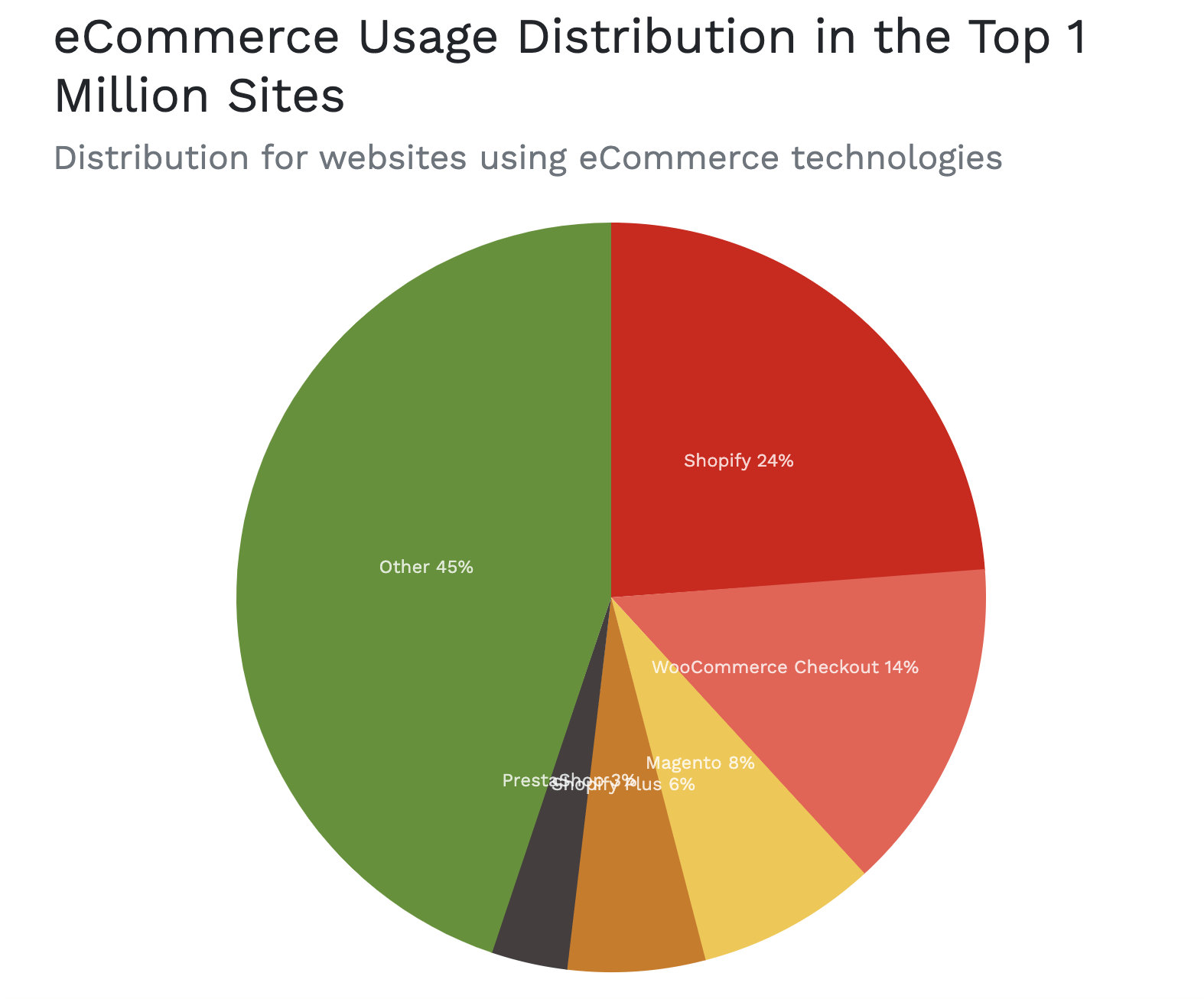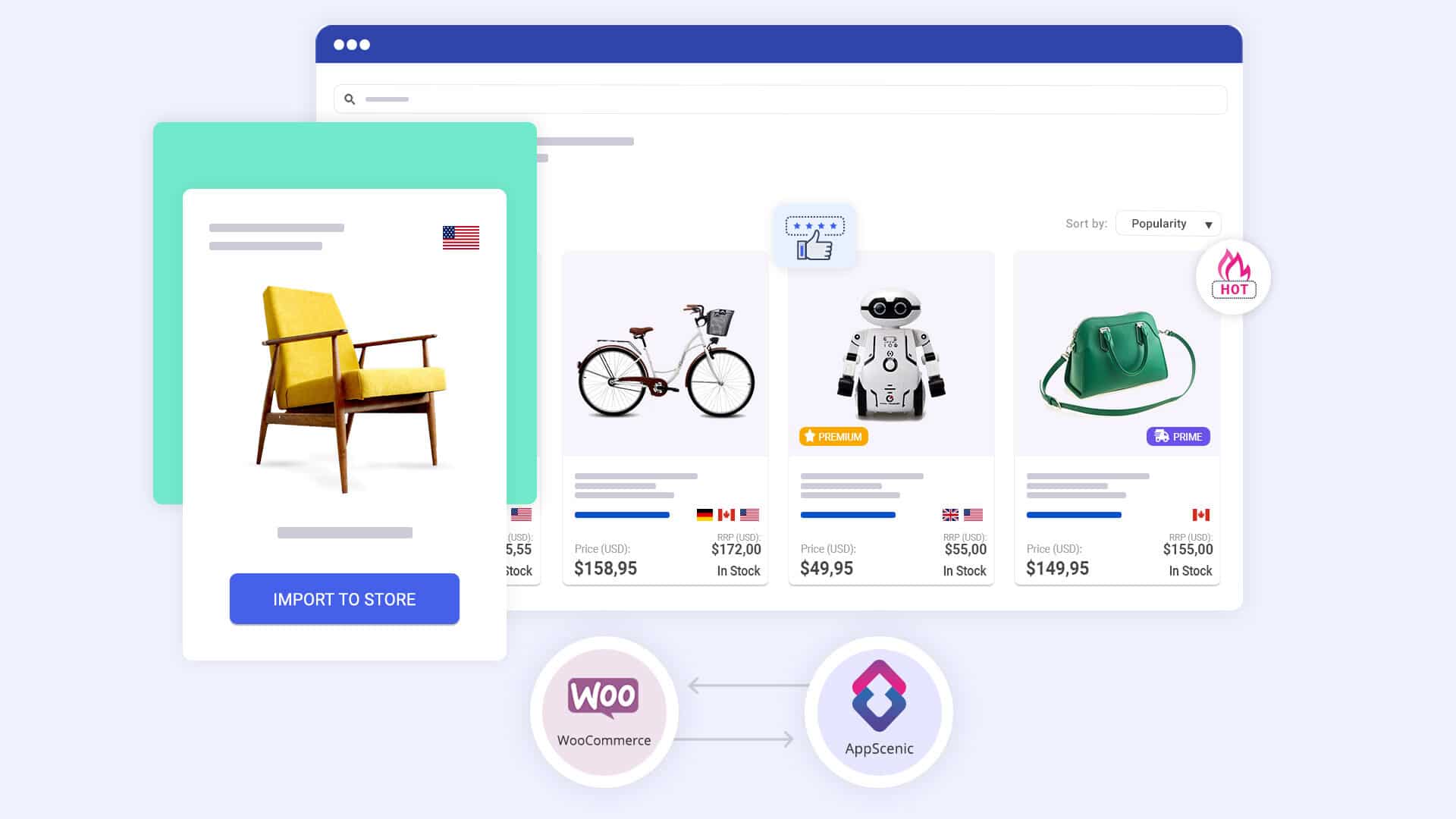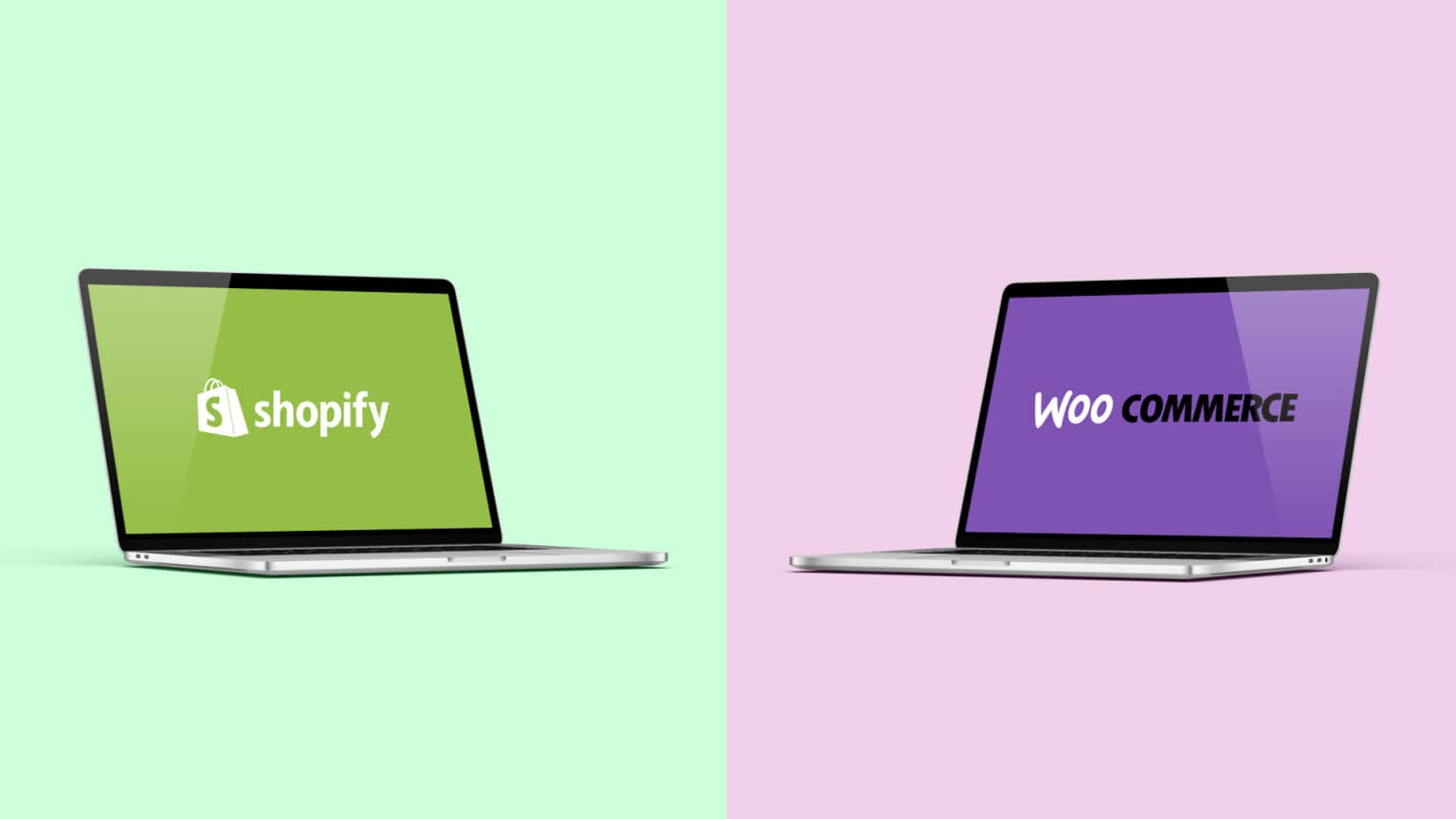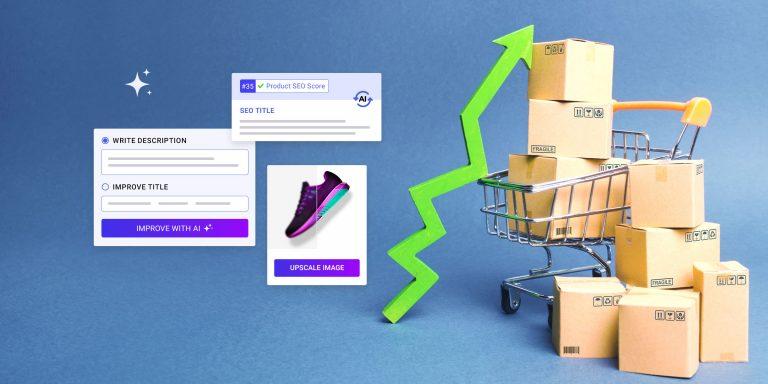If you are a dropshipping beginner, we’re sure you’ve already heard about the most popular ecommerce platforms on the market for running an online store.
Shopify and WooCommerce are two of the biggest ecommerce platforms in the world. Below, you can see a printscreen of the top ecommerce usage distribution in the top 1 million sites and what’s the distribution for websites using ecommerce technologies.
Now, as you can see 24% of these sites use Shopify while 14% use WooCommerce to power their online stores.

All this means that both of these platforms are great, have multiple strengths and therefore can be the perfect solution for you to build an ecommerce store with. More than that, choosing either Shopify and WooCommerce gives you the chance to do it all on your own, without any help from professional designers and/or developers.
But, which one should you choose for your dropshipping store? Which one is better for your dropshipping needs? Which features work for you and which is cheaper?
Now, in case you want to watch a video with these 2 platforms where we explain all these too, then go ahead and click on play below.
But if you prefer reading, then this article is for you and we promise that by the end of this article, you will find all your questions answered and make up your mind about which platform to choose.
So, here we go.
Table of Contents
What is Shopify and how to start
Shopify is an all-in-one ecommerce platform that gives you all the tools and features you need to setup your online store from the ground up. So, you have everything you need to manage your store within the platform, from web hosting to security, among others.
This actually means that a Shopify store is easy to setup as you won’t need any technical skills or other external help to run your store.
To start creating your first Shopify store, here are the first steps to take.
- Create a Shopify account
- Purchase a domain or if you have already one, you can simply integrate it with Shopify
- Pick your Shopify theme, install and then configure it
- Set up your shipping and payment settings and other Shopify features
- Import/create products
- Start selling
What is WooCommerce and how to start
On the other side, we have WooCommerce, the most popular ecommerce solution out there.
Why is it so popular? Well, essentially because WooCommerce is a WordPress plugin that was solely built for this platform and as you can imagine there are quite a few WordPress websites out there, and most important, both WordPress and WooCommerce are free to use.
So, if and when WordPress users want to change their website into an ecommerce store, they simply need to install the WooCommerce plugin.
Being an open source Content Management System (CMS) means you can just install it for free and therefore apply ecommerce functions and features to your existing site.
Once you decide to use WooCommerce for your first online store, you need to go through a few steps.
Now, the next steps apply to those of you who don’t have an existing WordPress website yet.
So, if you’re starting from scratch, here’s what you need to do:
- Set up a domain and web host
- Install WordPress
- Install WooCommerce plugin
- Pick a theme, install and then configure it to look according to your needs.
- Set up the WooCommerce features and settings, such as cards, payments, tax calculator, shipping zones, etc.
Check this guide on how to build your WooCommerce store step-by-step
What’s the main BIG difference between Shopify and WooCommerce?
As you probably figured it out, these two ecommerce platforms seem similar in a way, but actually, they offer quite different features and tools. We can even say they are built essentially differently for setting up your online store.
From the fact that WooCommerce and Shopify integrate differently into your business to the cost of each of them, both platforms have their own specific way to help you setup your ecommerce store.
On one hand, Shopify is built to deliver a complete ecommerce solution with all the features you need to create a store from the ground up. You can manage everything from the platform and you don’t need any other tool. Or at least this is what Shopify says.
On the other hand, WooCommerce is an open-source plugin that you can customize and model however you like for your business needs.
So, that’s probably the biggest difference between these two and is mentioned in all comparisons that are made between Shopify and WooCommerce that you can find online. One (Shopify) is built with everything in mind for all your ecommerce (basic) needs, being also cloud-hosted. The other (WooCommerce) is mainly built for more tech-savvy users for which you need to take care of the hosting.
This is pretty much the most common difference between Shopify and WooCommerce but as we will let you know below you will see is not necessarily correct.
Shopify can get really complicated as well once you start installing all kinds of apps to add new functionalities while WooCommerce can be easier to work with than you think if you set up and use it the right way from the start.
In other words, you’re probably going to choose Shopify if you want an all-in-one platform for your ecommerce store, one that will get your store running fast and has lots of the most common features and apps built-in.
Or, you will probably go for WooCommerce if you want more control over your store and maybe add some custom functionalities, as Shopify has its limits when you want to add complex features or when you need to connect it to some 3rd party tools or services.
Why choose Shopify?
To help you better understand what Shopify brings to the table, here are some pros and cons of the platform.
Pros
- Fixed pricing plans that you can pay monthly or yearly
- Multiple apps to extend your store. And a huge apps marketplace
- Multiple beautiful themes
- Shopify will take care of everything, from hosting to security
- You can launch your store in a day
- Dropshipping is simple with Shopify. Multiple apps built for dropshipping
- Good customer support.
- If you are eligible for Shopify Payments and you decide to use it, this means less headaches for you as this is their built-in payment method.

Cons
- You don’t have a lot of control over your site
- Not a lot of room for customization. Adding new functionalities can get really complicated
- You have a monthly payment that can get higher in time
- On top of the monthly/yearly subscription, you also need to pay a fee (0.5-2% based on the subscription plan) that can grow your monthly invoice exponentially
- Most of the apps are paid so basically for every new functionality you will need to add more to your monthly invoice
- The themes are beautiful but the best ones are very expensive
- Even though Shopify Payments is great to have, only companies incorporated in a few countries (USA, UK, AUS, CAN, BE, IT, JP, ES, BE, and a few others) are eligible to use it.
Why choose WooCommerce?
Here are some pros and cons to help you decide if WooCommerce is the right platform for you.
Pros
- You have complete customization and control
- Access to a huge online community online
- Endless themes and plugins
- Once you have a WordPress website, it’s easy to install and configure WooCommerce
- Both WordPress and WooCommerce plugins are free
- Cheap developers if you need extra help compared with Shopify which is 2-3x more expensive.
Cons
- It takes time to learn the basis of WordPress
- WooCommerce may end up being more expensive at the beginning due to plugins and themes but at least you pay for them once and not monthly
- You have to manage everything, be it hosting, security, maintenance, or backups
- Hosting is one of the main costs to run a WooCommerce store and it might be difficult at the beginning to configure it properly if you don’t have any experience with it. Fortunately, there are solutions for that.
What to keep in mind when choosing an ecommerce platform?
Now, before going into more details about each of these platforms, let’s see what are some things you need to keep in mind before making any decision.
How easy is it for you to use the platform
How much do you know about building websites and ecommerce stores? If this is not your first store or meeting with platforms like Shopify or WooCommerce, then you could definitely go for either of them depending on how much control you want to have over your store.
But if you’re just now starting out and it’s your first time building an online store from scratch, then Shopify’s user-friendliness will probably be great for you. For a newbie, WooCommerce can seem very intimidating, as there are a lot of technicalities you need to be used to already, especially at the beginning when you need to set up everything.
The right features
Here are the main features of Shopify:
- Mobile-friendly design
- Website builder
- Premium themes
- Blogging capabilities
- Social media integration
- SEO-ready site structure
- Email marketing integration
- Dropshipping capabilities
- Free SSL certificate
- Credit card payments.
Now, here are some of the features you can benefit from if you choose WooCommerce:
- Many payment gateways available
- Mobile-friendly design
- Adjustable shipping rates and taxes
- Possibility of selling both digital and physical products
- Complete control over your data
- Hundreds of plugins (extensions) available
- Customizable for all possible needs. If you need to build a marketplace, for example, that’s very easy to do and there are plenty of plugins for that, including free ones.
- Many integrations are available with all kinds of 3rd party services/platforms.
The price difference
Another big difference between these two platforms is the price you need to pay.
Now, as this subject is a bit more complex, we will try to break it down into initial costs and long-term costs.
The initial costs to setup an online store are crucial, of course. And that’s even more true if you’re a newbie and don’t have a big budget.

What’s the initial cost for Shopify?
A basic plan to get a Shopify ecommerce store up and running is $29 per month and can get up to $299/mo. On top of that, if you don’t have one, you may need to purchase a domain for your site, and can do that within Shopify at a starting cost of $14 per year.
So, to sum up, the initial cost to set up a very basic Shopify ecommerce store can get to $43 if you decide on the Basic Shopify plan.
That means the minimum price would be $43 and it will go up if you decide to install any new app or paid theme.
What’s the initial cost for WooCommerce?
As we already said WooCommerce is free but not exactly. What does that mean? It’s a free WordPress plugin that you don’t have to pay for. But you do need a domain name and hosting for your website, which actually means you have some initial costs to get started with WooCommerce.
So, if you are planning to launch a one-product store or a store around a small niche with just 40-50 products, then you can work with a basic WooCommerce hosting account that costs only about $10-20 per month.
You would also need to buy a domain name which costs around $10 in the first year. This gives us an initial cost of around $20-30 to get up and running a basic store with WooCommerce. Of course, you would pay more if you want to add a premium WooCommerce theme or any paid plugins for some extra functionalities.
So, as you can see the cost to start for both Shopify and WooCommerce is pretty much the same.
What about the long-term costs?
Now, things are a bit different when talking about the long-term costs. If you go for $29 per month to run your store on Shopify, then annually it will cost you $348 but this basic plan also comes with an additional 2% transaction fee, so, for example, if you sell let’s say $1000 a month for your first year, that’s $12,000 and the transaction fee would be $240 per year.
Let’s take another example. If you sell $500 per day, that’s around $15,000 per month and around $180,000 per year. In this case, you would pay $3600 in transaction fees.
If you choose WooCommerce, which is free, you only have the initial costs, the ones that we’ve pointed out above, and a total of approx. $400 per year for the hosting solution and for the domain name.
Of course, you would need to invest in better hosting if you are planning to add hundreds or even thousands of products to your store but we estimate that with around $50-100 per month you would be able to get a hosting that supports up to 5000-10,000 products or even more.
So, which is cheaper for a dropshipping beginner?
Again, if you only look at the costs, which we know how important are if you’re just starting, then both platforms are cheap enough in terms of initial costs.
But if you are serious about dropshipping and you want to do this for a long time, then you may choose WooCommerce as it’s much cheaper in the long run and more customizable.
Now, if you are thinking of setting up multiple stores, WooCommerce it’s definitely the solution if you are on a tight budget or you want to build a more complex ecommerce store with functionalities that are not available or are too expensive on Shopify.
Which platform is best for beginners?
If you are just starting in this ecommerce and dropshipping world, and are looking for a user-friendly platform that can help you setup a store from scratch without having a technical background, then Shopify is the perfect choice for you. If you want to launch your store super fast, then Shopify is the right solution for you. With Shopify, you can even have your store ready within a day.
The platform is intuitive and its drag and drop features make it so easy for you to customize your store and make it your own. Shopify is great for beginners who don’t mind not having a lot of control over their online store.
Now, if you do have a technical background in building an online store and you know your way around a WordPress website, then WooCommerce is perfect for you. It also gives you more control over a lot of aspects of your store. But we do advise you to keep in mind this ecommerce platform requires a hosting solution and you need to be sure your store is 100% secure.
So, if you don’t want to spend a lot of time choosing a hosting company, and want to setup an ecommerce site as fast and easy as possible, then Shopify is the best choice for you. WooCommerce can prove to be difficult for someone just starting in this world.
Here are 6 steps to a successful ecommerce business
Conclusion: Shopify or WooCommerce?
Again, it all depends on so many things, from the costs and features of each platform to the needs and technical skills of the dropshipper.
So, if you look at the features and how easy it is to use them, then you will probably choose Shopify. The fact that so many retailers chose Shopify in the last 4-5 years (it’s also the ecommerce platform with the highest growth) proves that this solution is great and would be more than capable to fit your business needs. Who doesn’t love a platform that helps you setup and run your online store without having to be technically savvy?
Of course, on the other hand, WooCommerce is much cheaper in the long run, has lots of functionalities and is more flexible and customizable. It’s therefore perfect as long as you have experience with managing a hosting account and/or have experience with the platform.
Now we know there has been a lot of stigma around WooCommerce and the platform being way too complicated to set up and configure. But, recently, there are more and more 3rd party companies that offer WooCommerce hosting solutions with pre-built and configured stores for you that are ready to go live in just a couple of hours.
So, there are easier ways now to make WooCommerce work even for those not very tech-savvy but still, you will need to learn a couple of things about how hosting works and how to maintain high-level security for your store.
To sum up, both platforms are great ecommerce platforms for starting up a dropshipping business. That’s why, in the end, it all comes down to your background, skillset, and how much time you want to spend launching your online store.
Where does AppScenic fit then?
As this article is intended for beginners, you may wonder where does AppScenic fits in this picture. Well, AppScenic is not your traditional ecommerce platform, you can’t use it to build a store. AppScenic is a dropshipping platform with over 1 million high-quality products from top suppliers located all over the world.

How does it work exactly? After you build your Shopify or WooCommerce store and you’re ready to start dropshipping, you can then register for an AppScenic Account. Check our WordPress plugin.
To setup your AppScenic account you have to go through a few simple steps, including adding your store and integrating AppScenic with your Shopify or WooCommerce stores.
If you want to give Shopify a chance, find more about our Shopify App.
Now, if you want to build a WooCommerce store, then check the AppScenic Plugin.
Here’s a step by step guide for beginners on how to start dropshipping with AppScenic
After you complete these steps, you can start importing and selling products through your store.
Once you are ready to dropship with AppScenic, you can register here











